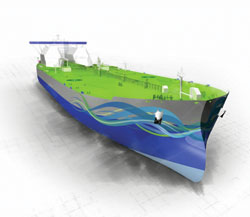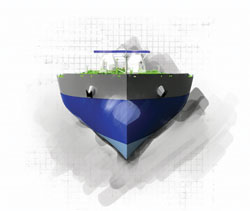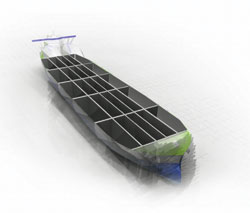Det Norske Veritas (DNV), the Norwegian classification society, has unveiled an innovative design concept for a very large crude carrier (VLCC) that eliminates the need for ballast tanks. Such a vessel, according to DNV, would prevent the spread of invasive species and reduce air pollution, yet would be cheaper to operate than a conventional tanker.
DNV calls the ballast-free tanker concept Triality because of its three main objectives: creating a VLCC that is environmentally superior, uses well-known technology and is financially attractive compared to conventional tankers. Key elements of the concept include giving the hull more of a V-shape and reconfiguring the cargo tanks in five longitudinal rows rather than the three rows typical of conventional tankers.
The discharge of ballast water from ships is largely responsible for the spread of invasive aquatic species around the world. In response to the problem, the industry is trying to find cost-effective ways of treating ballast water. DNV's ballast-free design holds the potential for an economically attractive and effective way to address the problem. While a VLCC of this design could cost 10 to 15 percent more to build than a conventional tanker, DNV estimates that over the life of the ship, the design would produce savings equal to 25 percent of the construction cost of a traditional VLCC.
Not intended for production, the Triality project identified existing technology that could also be applied to smaller Suezmax and Aframax tankers and other ships routinely traveling long distances unloaded.
 |
|
The Det Norske Veritas Triality design calls for a 1,184-foot-long oil tanker based on currently available technology. (Photo courtesy Det Norske Veritas) |
A ballast-free VLCC requires a drastically different hull design. A conventional unloaded VLCC would have a mean draft of 10 to 13 feet, so that the bow and propeller would be almost out of the water. The Triality, with a more V-shaped hull, provides full propeller immersion and sufficient forward draft to avoid bottom slamming when unloaded.
The 1,184-foot-long Triality design ship has a mean draft of about 23 feet unloaded and about 71 feet loaded. Also helping are the twin-screw propellers with diameters optimized for low-draft conditions.
When loading oil, a conventional VLCC empties its ballast tanks to avoid high bending moments, list or trim. The ballast-free Triality would have five longitudinal cargo sections — one center tank, two intermediate tanks and two side tanks — defined by four longitudinal bulkheads instead of the two commonly used in conventional tankers.
By filling or emptying a cargo section along its entire length, no longitudinal bending moments can result from uneven cargo weight along the length of the ship. The cargo piping fills or empties a complete longitudinal cargo section simultaneously. The location of the longitudinal bulkheads allows the tanks to be filled in sequence to avoid large heeling angles.
 |
|
The V-shaped hull permits the twin-screw propellers to be fully immersed even when the ship is carrying no cargo. (Photo courtesy Det Norske Veritas) |
The design aims to reduce operating costs by reducing the resistance of the hull as it moves through the water. A ship's resistance can be divided into viscous and wave-making resistance. The latter becomes more important at higher speeds. Since VLCCs operate at moderate speeds, resistance is dominated by viscous effects that are proportional to the vessel's wetted surface. The Triality hull design minimizes the wetted surface to reduce viscous resistance.
The design also tries to optimize the propeller conditions. The two propellers rotate in the same direction and with overlap to help reduce rotational energy losses.
The ballast-free Triality concept features dual large two-stroke, high pressure, slow-speed main engines from MAN Diesel & Turbo. They operate on liquefied natural gas (LNG) and use low-sulfur marine diesel for ignition and as a backup. (See related story, Page 4.) About 0.2 percent, or more than 500 tons, of a VLCC's cargo is lost via evaporation of volatile organic compounds (VOCs). Besides contributing greenhouse gases and resulting in ozone when VOCs react with NOx in sunlight, the lost vapors represent a financial loss, especially since VOCs are basically the most valuable light ends of crude oil.
 |
|
The five longitudinal cargo sections, rather than three, allow the ship to be loaded or unloaded without longitudinal bending moments. (Photo courtesy Det Norske Veritas) |
Triality uses the cold LNG to capture and condense the vapors into liquids that can be stored in deck tanks. Up to half will be used in special triple-fuel burners for the auxiliary boilers that produce steam for cargo pumps. The rest can be returned to the cargo tanks or delivered to shore during cargo discharge. These measures can reduce fuel consumption by 8 percent.
Besides eliminating ballast water, the Triality design could cut CO2 emissions by a third. It could also produce 80 percent less NOx as well as reduce SOx and particulate matter up to 95 percent, while using 25 percent less energy.
